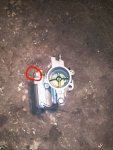It happened yesterday on the lake. I drove 9 miles away to the site. Everything works perfect.
When I returned, in the half way, the RPM slowly down from WOT to 1800 in 5 sec. Speed down from 30 mph to 7 mph.
The fuel tank almost empty. I thought it was because no fuel. So I combine both the almost empty tank together, which will be enough for return. The symptom remains, and I drove back to ramp with 6.5 mph, 1800 RPM. The idle is harsh and stroke to death if I get it engaged forward or backward. All I have to do is to push it forward quickly to make it drive forward and not die.
When I returned back to home, I checked the compression, all 120-130. Checked all the spark, all 1/2-3/4 gap sparked. Checked the fuel filter, no clogged. Checked the spark plugs, all seems fuel soaked and carbon ed, very dirty, but they still sparked with a in-line tester.
What's the reasons for losing power?
1. Residue in fuel tank? I did see small black pieces in the tank when I tried to move left gas fuel to the other tank. One tank has at least 6 months gas in it.
2. Water in fuel tank? I do not know and don't know how to check it.
3. Sparks? It didn't sound to me a lost of cylinders, but it does have more vibration when I drive. I can feel it. At that time, I am afraid if they can be overheat and burned if it is because of short of fuel.
When I returned, in the half way, the RPM slowly down from WOT to 1800 in 5 sec. Speed down from 30 mph to 7 mph.
The fuel tank almost empty. I thought it was because no fuel. So I combine both the almost empty tank together, which will be enough for return. The symptom remains, and I drove back to ramp with 6.5 mph, 1800 RPM. The idle is harsh and stroke to death if I get it engaged forward or backward. All I have to do is to push it forward quickly to make it drive forward and not die.
When I returned back to home, I checked the compression, all 120-130. Checked all the spark, all 1/2-3/4 gap sparked. Checked the fuel filter, no clogged. Checked the spark plugs, all seems fuel soaked and carbon ed, very dirty, but they still sparked with a in-line tester.
What's the reasons for losing power?
1. Residue in fuel tank? I did see small black pieces in the tank when I tried to move left gas fuel to the other tank. One tank has at least 6 months gas in it.
2. Water in fuel tank? I do not know and don't know how to check it.
3. Sparks? It didn't sound to me a lost of cylinders, but it does have more vibration when I drive. I can feel it. At that time, I am afraid if they can be overheat and burned if it is because of short of fuel.
Last edited:






















